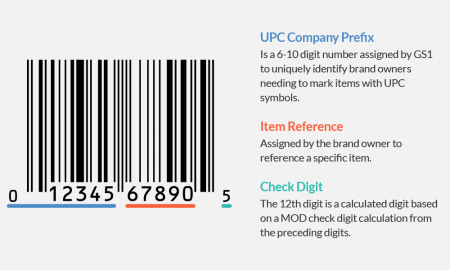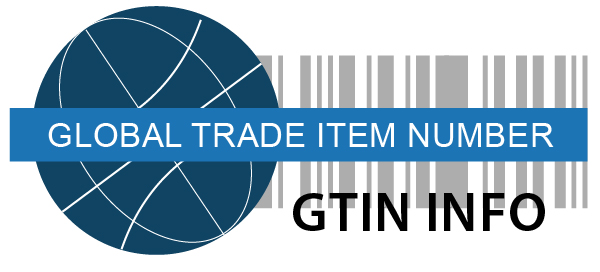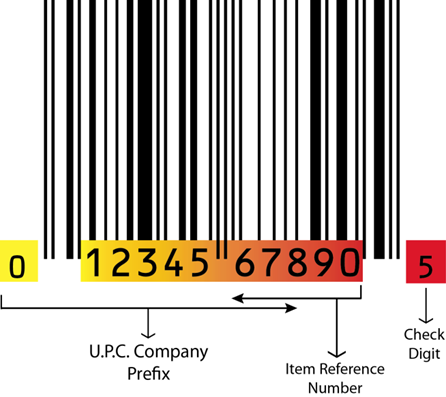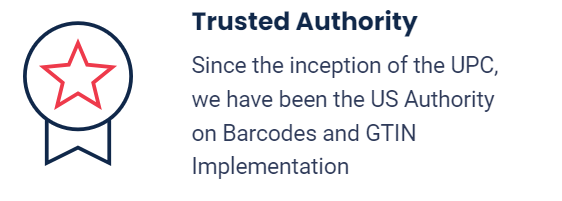How UPC Codes Relate to GTINs & UPC barcodes
The term “UPC Code” is part of the American vocabulary. Still, it technically doesn’t mean what most people think it does. There are many terms and acronyms used to define the black-and-white symbols included on almost every product. Words such as; UPC, barcode, UPC Code, UPC barcode, SKU, UPC-A, and GTIN, are commonly used interchangeably and incorrectly.
Standardized barcode identification began in the early 1970’s and proliferated throughout various retail sectors, from grocery stores to general retail outlets. The explosive growth of e-commerce, driven by giants such as Amazon and Walmart, has magnified the importance of standardized barcode identification. Product tracking, inventory management, and sales processing are reliant on this concept. The information below will help clarify many misunderstandings, and also provide guidance on how to correctly identify products with global standardized barcodes.
What is a UPC Code?
The acronym, UPC, stands for Universal Product Code. Consequently, the phrase UPC Code is redundant (Universal Product Code Code). However, due to the term’s popularity and mass misunderstanding, it unlikely it will change any time soon. That being said, a Universal Product Code is a numeric 12-digit identifier that is based on a global standardized structure.
A UPC code is pivotal for both small and large businesses in bringing their products to market. Essential items, including food, coffee, home goods, and apparel, all depend on these barcodes for streamlined distribution and sales. The global standard is managed by an international body called GS1. GS1 and their local country offices do not make barcodes, but create the identification guidelines and administer the licensing of standardized identifiers. As described on this website, a GTIN (Global Trade Item Number) is the umbrella term for this global product identifier, and a UPC is a form of a GTIN.
The Difference Between a UPC & UPC Barcode
Barcode symbols are referred to as “data carriers”. There are numerous types of barcode languages, and UPC-A coincidentally happens to also be the name of the most popular barcode language. Unlike a QR Code, which can encode web addresses, raw data, and contact information, the UPC-A barcode can only encode 12 numeric digits.
The UPC (aka UPC code) is the actual 12-digit identifier and the UPC-A barcode encodes the data. In the example to the right, the UPC data “012345678905′ is encoded in the UPC-A barcode.

Barcode US helps connect your items’ product data to unique UPCs (GTIN-12s) and provides the actual UPC barcodes, that enable businesses to sell their products globally. With Barcode US, your entrepreneurial idea can blossom and scale into a thriving global enterprise. When scanned, the UPC data (GTIN-12) allows point-of-sale systems to accurately retrieve the item’s details, ensuring efficient and reliable transaction processing. This system not only streamlines sales and inventory management. but also supports accurate pricing and product tracking throughout the retail industry.
How To Get UPCs and UPC Barcodes
Get Single Barcodes | License Prefix for 10 Barcodes | License Prefix for 100 Barcodes | |
Starting at $70 | Total Fee: $400 | Total Fee: $1,000 | |
Unique Product Identifier(s) | 10 GTINs | 100 GTINs | |
Digital .EPS Barcode(s) | 10 Barcodes | 100 Barcodes | |
Acesss to GTIN.cloud® | |||
Official GS1 Certificate | |||
Data Validation | |||
Annual Renewal Fee | |||
Supports Cartons & Pallets | |||
Enables Couponing | |||
Identify Medical Devices | |||
UPC Code vs. SKU vs. Part Number
As indicated above, a UPC Code is a global standardized 12-digit number used to identify items. The benefit of a standardized identifier is that trading partners around the globe can use trust and use the same UPC (GTIN-12) to recognize your products. This is why proper UPC product identification is crucial.
Two common identifiers used within specific environments are an SKU (Stock Keeping Unit) and a manufacturer’s part number. An SKU is an internal identifier used by individual retailers. It enables retailers to track sales data and inventory associated with the manufacturer’s UPC code. In certain situations, a retailer may rely on different UPC codes, but they can assign an SKU for that product type to keep track of all the barcodes associated with that item. For example, a pair of gloves that a retailer sells can have a different UPC for every color and size variation, and to properly track all the various UPCs, the retailer creates one unique SKU number. Two retailers can sell the same item with the same UPC codes, but they will both use their own internal SKU number.
Some manufacturers also maintain separate product numbers for their products. Each internal operating environment may vary and certain systems rely on their own identifiers. Companies do not have to match their own product numbers to the same as the item reference numbers within a UPC code (GTIN-12).
Do I need A UPC Code?
Identifying items with UPC codes is completely voluntary, and there are no legal requirements to use them. It is important to note that your products will most likely not be accepted at most retailers and online marketplaces. Even if you are selling products solely on your own website, if you hope to get high rankings on Google, you will be asked to include a UPC (GTIN-12) when listing your products.
In today’s marketplaces, UPCs will help you keep track of sales for your products and allow you to sell your products anywhere. In addition, the Company Prefix GTIN data for items also corresponds to identification standards involving case packaging, shipping labels, and even manufacturers’ coupons.
The Importance of Doing it Correctly
Without an authentic UPC code licensed to your company, selling and tracking your goods through the global supply chain is not possible. For most retailers, including Walmart, Home Depot, Kroger, Whole Foods and Amazon) having a correctly licensed UPC code on your product is a requirement to sell it. The internet is full of misinformation and unauthorized discount UPC resellers.
The Role of Barcode US
Barcode US’s team of certified GS1 Barcode consultants assists tens of thousands of companies every year with their new and ongoing GTIN assignments. The global standards organizations only provide the technical guidelines, licensin., and educational programs, They do not assign GTINs to products or provide precise digital barcodes. Barcode US is the only source to obtain company-registered UPC barcodes with personal support from a GS1 consultant. Access to the GTIN.cloud central UPC product data registry is automatically included. This portal enables companies to manage GTINs, create barcodes, and illustrate to retailers (ie Amazon) that their GTINs are associated with an active Company Prefix certificate.
Barcode US Benefits
UPC Codes
“You Keep Using That Word, I Do Not Think It Means What You Think It Means”
Inigo Montoya, The Princess Bride.






